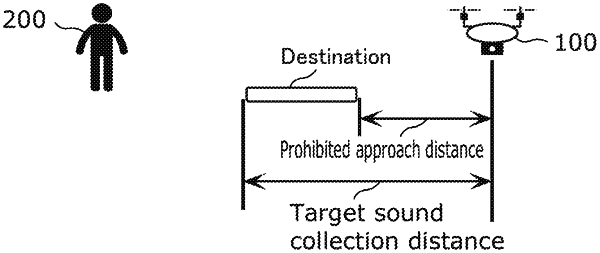| CPC G05D 1/005 (2013.01) [G10L 25/48 (2013.01); H04R 1/32 (2013.01); B64U 10/14 (2023.01); B64U 2101/30 (2023.01); B64U 2201/00 (2023.01); B64U 2201/104 (2023.01); H04R 2440/00 (2013.01)] | 18 Claims |

|
1. An unmanned aerial vehicle, comprising:
a sensor including at least a microphone that collects a target sound that is a sound from a sound source and generates sound data of the target sound collected; and
a processor,
wherein the processor performs:
determining a quality of the target sound by using the sound data generated by the microphone;
acquiring a positional relationship between the unmanned aerial vehicle and the sound source of the target sound by using data generated by the sensor, the positional relationship including a distance between the unmanned aerial vehicle and the sound source and a first position of the sound source relative to the unmanned aerial vehicle, the first position being a position of the sound source at which the target sound corresponding to the sound data is collected;
determining, by using the quality of the target sound determined and the distance measured, a target distance between the unmanned aerial vehicle and the sound source, the target distance being for collecting a target sound having a targeted quality level that is predetermined;
determining a destination to which the sound source is to move based on (i) the quality of the target sound determined, (ii) the target distance determined, (iii) a predetermined distance to be maintained between the unmanned aerial vehicle and the sound source, and (iv) the positional relationship; and
presenting target movement information that prompts the sound source to move toward the destination,
wherein when the target distance is longer than or equal to the predetermined distance and the quality of the target sound is lower than the targeted quality level, in the determining of the destination, the processor determines, as the destination, a second position closer to the unmanned aerial vehicle than the first position is to, or
when the target distance is shorter than the predetermined distance, in determining the destination, the processor determines, as the destination, a third position spaced apart from the unmanned aerial vehicle by the predetermined distance.
|